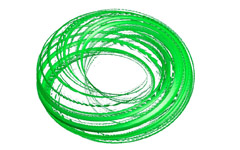Computer and brain-logic gates (Vol. 45 No. 1)
 An illustration for the differences between computer and brain logic-gates.
An illustration for the differences between computer and brain logic-gates.
This year we are celebrating the 70th anniversary of the publication of the seminal work by McCulloch and Pitts "A logical calculus of the ideas immanent in nervous activity". They suggested that the brain is composed of threshold units, neurons, composing reliable logic-gates similar to the logic at the core of today's computers. This suggested computational framework had a tremendous impact on the development of artificial neural networks and machine learning theory, but had limited impact on neuroscience, since neurons exhibit far richer dynamics. Here we propose a new experimentally corroborated paradigm in which the functionality of the brain's logic-gates depends on the history of their activity, the stimulation frequencies of their input neurons, as well as the activity of their interconnections. Our results are based on an experimental procedure where conditioned stimulations were enforced on circuits of neurons embedded within a large-scale network of cortical cells in-vitro. We demonstrate that the underlying biological mechanism is the unavoidable increase of neuronal response latency to ongoing stimulations, which imposes a non-uniform gradual stretching of network delays. This computational paradigm is anticipated to lead to better understanding of the brain's functionalities.
R. Vardi, S. Guberman, A. Goldental and I. Kanter, “An experimental evidence-based computational paradigm for new logic-gates in neuronal activity”, EPL, 103, 66001 (2013).
[Abstract]
A topological analysis of plasma flow structures (Vol. 45 No. 1)
 Filamentary structure of plasma turbulence.
Filamentary structure of plasma turbulence.
In toroidally confined plasmas and from a fluid perspective, plasma turbulence is characterized by the existence of multiple vortices located at the magnetic surfaces where the magnetic field lines close on themselves after a finite number of turns around the torus. When we look at transport in such systems, we see that these vortices may cause the trapping of particles, while large scale flows may carry them from vortex to vortex. We develop an analysis approach that has allowed us a complete characterization of the structures of the vortices, determining which ones form close loops, cycles, and which ones have just a finite length, filaments, and make a determination of their length. By comparing these structures at different times we also can determine the life times of the cycles. We have found that both life times of the cycles and lengths of the filaments are well described by lognormal distributions. Having the distribution of the life times of the cycles and lengths of the filaments, we can connect them to the trapping time of particles moving with the turbulence.
B. A. Carreras, I. Llerena Rodríguez and L. García, “A topological analysis of plasma flow structures”, J. Phys. A: Mth. Theor., 46, 375501 (2013)
[Abstract]





